Bone Grafting
Missing teeth over a period of time can cause your jaw bone to atrophy, or resorb. This often results in poor quality and quantity of bone suitable for the placement of dental implants as well as long term shifting of remaining teeth and changes to facial structure. Most patients, in these situations, are not candidates for dental implants.
Fortunately, today we have the ability to grow bone where it is needed. This not only gives us the opportunity to place implants of proper length and width, but it also gives us a chance to restore functionality and aesthetic appearance.
Bone grafting can repair implant sites with inadequate bone structure due to previous extractions, gum disease, or injuries. Bone grafting involves the use of a bone substitute and a membrane, which are used to reform the desired contours of a particular area following bone loss. Over time, the body will replace this bone with its own bone in a process known as Guided Bone Regeneration. This type of grafting is carried out commonly with Bovine (cow) bone graft together with a porcine (pig) barrier membrane.
Major bone grafts are typically performed to repair defects of the jaws. These defects may arise as a result of traumatic injuries, tumor surgery, or congenital defects. Large defects are repaired using the patient’s own bone. This bone is harvested from a number of different areas depending on the size needed. These procedures are routinely performed in an operating room and require a hospital stay.
Ridge augmentation - Socket preservation:
is a common dental procedure often performed following a tooth extraction. This procedure helps recreate the natural contour of the gums and jaw that may have been lost due to bone loss from a tooth extraction, or for another reason.
The alveolar ridge of the jaw is the bone that surrounds the roots of teeth. When a tooth is removed an empty socket is left in the alveolar ridge bone. Usually this empty socket will heal on its own, filling with bone and tissue. Sometimes when a tooth is removed the bone surrounding the socket breaks and is unable to heal on its own. The previous height and width of the socket will continue to deteriorate.
Rebuilding the original height and width of the alveolar ridge is not always medically necessary, but may be required for dental implant placement or for aesthetic purposes. Dental implants require bone to support their structure and a ridge augmentation can help rebuild this bone to accommodate the implant.
 Before
Before
Cross-section of a jaw that has lost volume following tooth loss. There is not enough bone to safely place a dental implant.
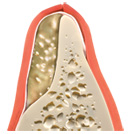 During healing
During healing
The patient's cells migrate into the allograft material and remodel it into new bone. Over time host bone will remodel to replace the allograft.
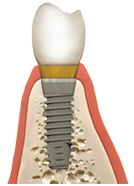
After
Restored jaw now has adequate room for placement of a dental implant to replace the missing tooth.
WHERE DOES BONE GRAFTING MATERIAL COME FROM?
Bone grafting material comes from several sources. Autograft bone is material that is taken from another point in the patient's body and transplanted to the desired site. It is a good graft material since it contains the patient's own cells, and carries no risk of disease transmission. The chief drawbacks are that it requires a second surgical procedures and enough harvestable bone that may not be easily available.
 after extraction
after extraction
When your doctor removes a damaged tooth, it leaves behind a void where the tooth was. Bone loss occurs without the tooth present to stimulate the jaw bone.
 socket grafting with allograft bone
socket grafting with allograft bone
Your doctor may choose to place some allograft bone graft material in the void left behind. This will promote bone growth.
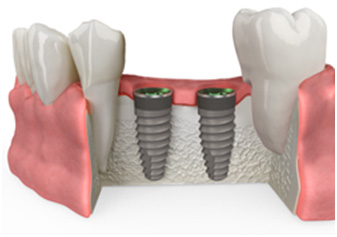 healing phase
healing phase
The bone graft material provides the structure for your body's cells to migrate to the void and remodel the graft into your own bone tissue. After healing your jaw bone will better support dental implants.
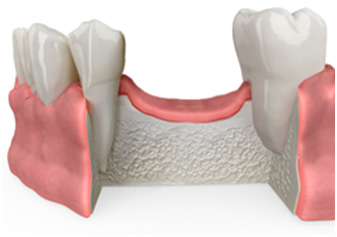 lost bone
lost bone
Bone loss occurs when teeth are no longer present to stimulate the bone. Too much bone loss will require a ridge augmentation procedure to rebuild the lost bone so dental implants can be placed.
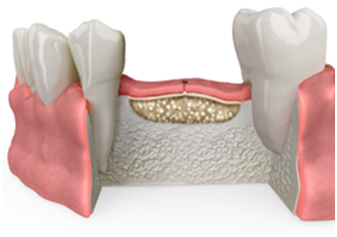 restore your bone
restore your bone
You doctor will use the bone graft material to restore your jaw bone to its natural shape so it can support dental implants.
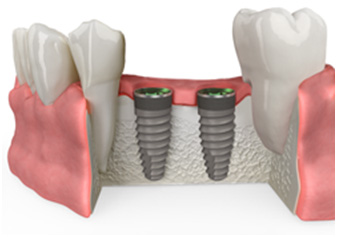 restoring your smile
restoring your smile
Once your body has had a chance to heal and remodel the graft, your doctor can now place dental implants and restore your smile.
Sinus augmentation
Following the loss of the upper posterior teeth, the resulting force differences can allow the air sinus in the area to increase in size. This in turn means that the bone height available for implant placement in this area may be diminished. In order to replace the volume of bone in these areas to allow the successful placement of implants, sinus elevation and grafting procedures can be carried out. This is a more involved procedure but one which is carried out regularly in the clinic.
During this procedure the sinus is accessed and the lining gently elevated allowing bone graft material to be placed forming increased foundation for the placement of implants. By this procedure we can achieve good and predictable results without which many patients would be unable to have implants.
Sinus augmentation has been shown to greatly increase your chances for successful implants that can last for years to come. Many patients experience minimal discomfort during this procedure.
Onlay grafting
Onlay grafting – Where severe bone loss has occurred requiring either a large increase in volume, or a potential increase in vertical bone height, bone volume can be increased by taking by a piece of bone from elsewhere in the mouth and transferring it to the deficient area. The new piece of bone when healed and matured will then be capable of taking an implant. Most commonly, such grafts are taken from the chin region or from the back area of the lower jaw.
Does bone grafting affect the length of treatment?
Almost invariably treatment time is longer when bone grafting is required – however the process greatly improves the outcome of the implant treatment.
In certain situations the placement of the implant alongside the bone grafting with the use of a barrier membrane all at the same time will be recommended. This considerably reduces treatment time and can produce results that are difficult to achieve in any other way, however, many surgeons will still prefer to carry out bone grafting as a distinct stage, so that the implants are only placed when the bone grafting has been successful.
